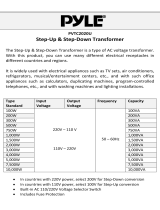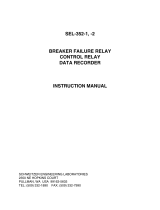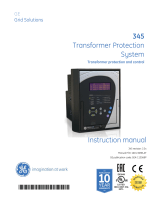
with enhanced security, the command is processed
and the resulting position is supervised.
Normal security means that only the command is
evaluated and the resulting position is not
supervised. Enhanced security means that the
command is evaluated with an additional
supervision of the status value of the control object.
The command security with enhanced security is
always terminated by a CommandTermination
service primitive.
Control operation can be performed from the local
HMI under authority control if so defined.
Voltage control TR1ATCC (90), TR8ATCC (90),
TCMYLTC and TCLYLTC (84)
The voltage control functions, Automatic voltage
control for tap changer, single control TR1ATCC
(90), Automatic voltage control for tap changer ,
parallel control TR8ATCC (90) and Tap changer
control and supervision, 6 binary inputs TCMYLTC
(84) as well as Tap changer control and supervision,
32 binary inputs TCLYLTC (84) are used for control
of power transformers with a motor driven load tap
changer. The functions provide automatic regulation
of the voltage on the secondary side of
transformers or alternatively on a load point further
out in the network.
Control of a single transformer, as well as control of
up to eight transformers in parallel is possible. For
parallel control of power transformers, three
alternative methods are available, the master-
follower method, the circulating current method and
the reverse reactance method. The two former
methods require exchange of information between
the parallel transformers and this is provided for
within IEC61850-8-1.
Voltage control includes many extra features such
as possibility of to avoid simultaneous tapping of
parallel transformers, hot stand by regulation of a
transformer in a group which regulates it to a
correct tap position even though the LV CB is open,
compensation for a possible capacitor bank on the
LV side bay of a transformer, extensive tap changer
monitoring including contact wear and hunting
detection, monitoring of the power flow in the
transformer so that for example, the voltage control
can be blocked if the power reverses etc.
Logic rotating switch for function selection and
LHMI presentation SLGGIO
The logic rotating switch for function selection and
LHMI presentation function (SLGGIO) (or the
selector switch function block) is used to get a
selector switch functionality similar to the one
provided by a hardware selector switch. Hardware
selector switches are used extensively by utilities, in
order to have different functions operating on pre-
set values. Hardware switches are however sources
for maintenance issues, lower system reliability and
an extended purchase portfolio. The logic selector
switches eliminate all these problems.
Selector mini switch VSGGIO
The Selector mini switch VSGGIO function block is
a multipurpose function used for a variety of
applications, as a general purpose switch.
VSGGIO can be controlled from the menu or from a
symbol on the single line diagram (SLD) on the local
HMI.
Single point generic control 8 signals SPC8GGIO
The Single point generic control 8 signals
(SPC8GGIO) function block is a collection of 8
single point commands, designed to bring in
commands from REMOTE (SCADA) to those parts
of the logic configuration that do not need extensive
command receiving functionality (for example,
SCSWI). In this way, simple commands can be sent
directly to the IED outputs, without confirmation.
Confirmation (status) of the result of the commands
is supposed to be achieved by other means, such
as binary inputs and SPGGIO function blocks. The
commands can be pulsed or steady.
AutomationBits, command function for DNP3.0
AUTOBITS
AutomationBits function for DNP3 (AUTOBITS) is
used within PCM600 to get into the configuration of
the commands coming through the DNP3 protocol.
The AUTOBITS function plays the same role as
functions GOOSEBINRCV (for IEC 61850) and
MULTICMDRCV (for LON).
Transformer protection RET670 ANSI
1MRK 504 118-BUS A
Pre-configured
Product version: 1.2
ABB 19






















